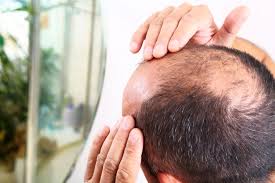Male pattern baldness, scientifically known as androgenetic alopecia, is the most common cause of hair loss in men. It affects approximately 50% of men over the age of 50, with some experiencing hair thinning as early as their 20s. This hereditary condition is primarily influenced by hormones, particularly dihydrotestosterone (DHT), which causes hair follicles to shrink and eventually stop producing hair.

Causes of Male Pattern Baldness
1. Genetics
Male pattern baldness is hereditary, passed down from either the maternal or paternal side of the family. If your close relatives have experienced hair loss, you are at a higher risk.
2. Hormonal Influence (DHT)
Dihydrotestosterone (DHT) is a derivative of testosterone. It binds to hair follicles, causing them to shrink, weaken, and eventually cease producing hair.
3. Aging
As men age, hair growth slows down, and follicles become more sensitive to DHT, leading to increased hair thinning and baldness.
4. Lifestyle Factors
Poor nutrition, stress, smoking, and excessive alcohol consumption may contribute to accelerated hair loss.
Treatment Options for Male Pattern Baldness
1. Medications
Finasteride (Propecia)
- A prescription oral medication that inhibits DHT production.
- Slows hair loss and may promote regrowth.
Minoxidil (Rogaine)
- A topical solution applied to the scalp.
- Increases blood flow to hair follicles, stimulating growth.
2. Hair Transplant Surgery
Follicular Unit Extraction (FUE) and Follicular Unit Transplantation (FUT) are surgical methods that transplant healthy hair follicles from donor areas to balding regions.
3. Platelet-Rich Plasma (PRP) Therapy
PRP involves injecting platelet-rich plasma from the patient’s blood into the scalp to stimulate hair follicles and promote regrowth.
4. Low-Level Laser Therapy (LLLT)
Laser therapy devices enhance blood circulation to the scalp and may slow hair loss progression.
5. Lifestyle and Natural Remedies
- Balanced Diet: Nutrients like biotin, zinc, and omega-3 fatty acids support hair health.
- Scalp Massage: Stimulates blood circulation, which may strengthen follicles.
- DHT-Blocking Shampoos: Reduce scalp DHT levels and support hair retention.
Preventing Male Pattern Baldness
Although complete prevention is not always possible, the following strategies may slow the process:
- Maintain a healthy diet rich in vitamins and minerals.
- Reduce stress through meditation, exercise, and adequate sleep.
- Avoid excessive heat styling and harsh chemical treatments.
- Regularly use mild shampoos and conditioners designed for hair loss prevention.
Male pattern baldness is a common and often hereditary condition caused by the effects of DHT on hair follicles. While there is no permanent cure, various treatments, including medications, hair transplants, and laser therapy, can slow hair loss and restore hair density. Early intervention and adopting a healthy lifestyle can help manage and reduce the impact of male pattern baldness.